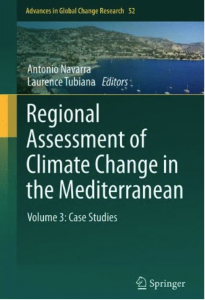Volume 3: Case Studies
Editors: Antonio Navarra, Laurence Tubiana
ISBN: 978-94-007-5768-4 (Print) 978-94-007-5769-1 (Online)
Series Title: Advances in Global Change Research
Series Volume: 52
Series ISSN: 1574-0919
DOI: 10.1007/978-94-007-5769-1
Publisher: Springer Netherlands
Volume 3 presents case studies performed in CIRCE, representing urban, rural and coastal environments and drawn from the north and the south of the Mediterranean shore.
Chapter 4: Hemming, D.; Agnew, M.D.; Goodess, C.M.; Giannakopoulos, C.; Salem, S.B.; […] ; Lionello, P […];(2013) Climate Impact Assessments, in (A.Navarra and L.Tubiana eds) Regional Assessment of Climate Change in the Mediterranean, Advances in Global Change Research 52, 61-104, Springer Netherlands, ISBN: 978-94-007-5768-4 (Print) 978-94-007-5769-1 (Online)
Abstract
This chapter highlights key climate impacts, hazards and vulnerabilities and associated indicators that have been used to assess current (recent) climate impacts at each of the case-study sites. The aim is to illustrate some of the wide range of information available from individual case studies and highlight common themes that are evident across multiple case-study locations. This is used to demonstrate linkages and sensitivities between the specific climate impacts of relevance for each case-study type (urban, rural and coastal) and the key climate hazards and biogeophysical and social vulnerabilities representing the underlying drivers and site conditions. For some impacts, there are clear, direct links with climate events, such as heat stress and flooding, while for others, such as energy supply and demand, the causal relationships are more indirect, via a cascade of climate, social and economic influences. Water availability and extreme temperatures are common drivers of current climate impacts across all case studies, including, for example, freshwater supply and heat stress for urban populations; irrigation capacity and growing season length for agricultural regions; and saltwater intrusion of aquifers and tourist visitor numbers at coastal locations. At some individual case-study locations, specific impacts, hazards and/or vulnerabilities are observed, such as peri-urban fires in Greater Athens, infrastructure vulnerability to coastal flooding in Alexandria, groundwater levels in Tel Hadya and vector-borne diseases in the Gulf of Oran. Throughout this chapter, evidence of current climate impacts, hazards and vulnerabilities from each of the case studies is detailed and assessed relative to other case studies. This provides a foundation for considering the wider perspective of the Mediterranean region as a whole, and for providing a context from which to assess consequences of future climate projections and consider suitable adaptation options.
CMCC Institutes
CMCC Divisions


